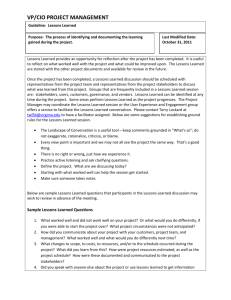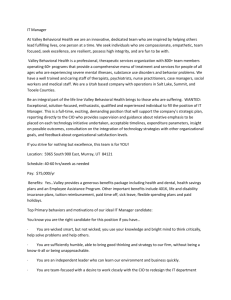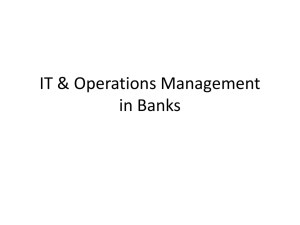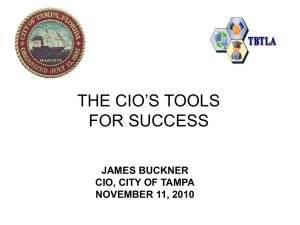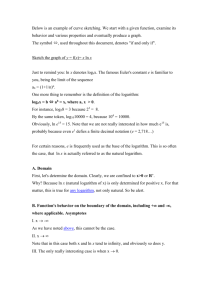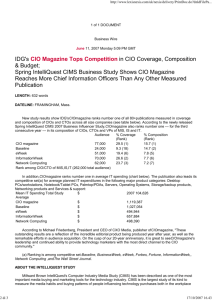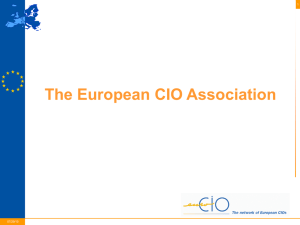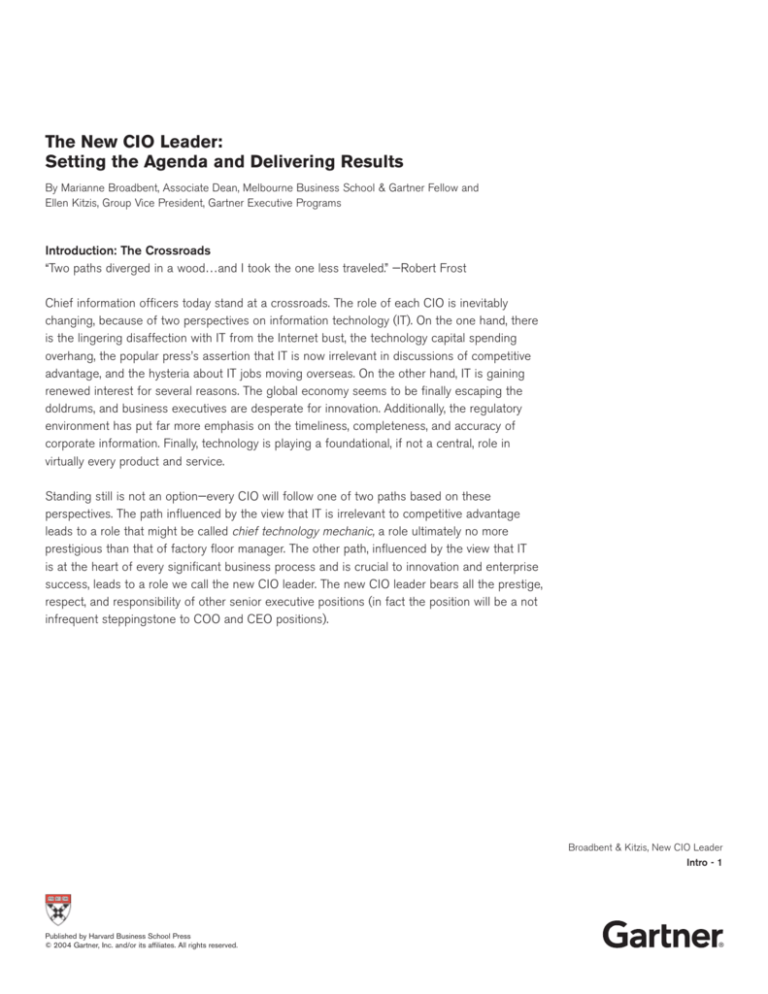
The New CIO Leader:
Setting the Agenda and Delivering Results
By Marianne Broadbent, Associate Dean, Melbourne Business School & Gartner Fellow and
Ellen Kitzis, Group Vice President, Gartner Executive Programs
Introduction: The Crossroads
“Two paths diverged in a wood…and I took the one less traveled.” —Robert Frost
Chief information officers today stand at a crossroads. The role of each CIO is inevitably
changing, because of two perspectives on information technology (IT). On the one hand, there
is the lingering disaffection with IT from the Internet bust, the technology capital spending
overhang, the popular press’s assertion that IT is now irrelevant in discussions of competitive
advantage, and the hysteria about IT jobs moving overseas. On the other hand, IT is gaining
renewed interest for several reasons. The global economy seems to be finally escaping the
doldrums, and business executives are desperate for innovation. Additionally, the regulatory
environment has put far more emphasis on the timeliness, completeness, and accuracy of
corporate information. Finally, technology is playing a foundational, if not a central, role in
virtually every product and service.
Standing still is not an option—every CIO will follow one of two paths based on these
perspectives. The path influenced by the view that IT is irrelevant to competitive advantage
leads to a role that might be called chief technology mechanic, a role ultimately no more
prestigious than that of factory floor manager. The other path, influenced by the view that IT
is at the heart of every significant business process and is crucial to innovation and enterprise
success, leads to a role we call the new CIO leader. The new CIO leader bears all the prestige,
respect, and responsibility of other senior executive positions (in fact the position will be a not
infrequent steppingstone to COO and CEO positions).
Broadbent & Kitzis, New CIO Leader
Intro - 1
Published by Harvard Business School Press
© 2004 Gartner, Inc. and/or its affiliates. All rights reserved.
®
“The New CIO Leader: Setting the Agenda and Delivering Results”, Ellen Kitzis & Marianne Broadbent
Gartner, Inc., Harvard Business School Press
As CIOs examine these paths, there is good news and bad news. The good news is that
each CIO largely controls what path he or she will follow—becoming a new CIO leader is
within the reach of every CIO who aspires to it. The bad news is that each CIO largely
controls what path he or she will follow—the responsibility for the outcome rests on the
individual’s shoulders alone. Becoming a new CIO leader requires changes to the skills,
approach, and priorities that CIOs have traditionally had. For the most part, these changes are
evolutionary, not revolutionary; you will see no “everything is different now” statements here.
Although these changes may lack the glamour of revolution, a CIO who does not make these
changes will almost inevitably face extinction as an executive. To be clear, CIOs who
consciously or unconsciously fail to make the shifts we discuss in this book and who become
mere technology mechanics will not eliminate the role of new CIO leader in their
organization—they simply won’t have the job themselves. They will be working for someone
who has embraced these changes.
If you think you are a new CIO leader, then the challenge for you is to continue to be
one. If you’re not changing and growing as your enterprise changes, then you’re not keeping
up. If you don’t think like a constantly “re-new-ing”, you may be on your way to becoming an
ex-CIO. The demands on CIOs are changing that much and that fast.
This book is the culmination of years of research and hundreds of in-depth interactions
we’ve had with CIOs and their executive colleagues. This research also includes Gartner’s
annual CIO survey, which captures the priorities and agenda of CIOs from organizations all
around the world. In 2004, more than 950 CIOs took part. The largest survey of its kind, it
examines the balance between business, strategic, technical, and management priorities.
Statistical data on CIOs throughout the book are drawn from these annual surveys.
Broadbent & Kitzis, New CIO Leader
Intro - 2
Published by Harvard Business School Press
© 2004 Gartner, Inc. and/or its affiliates. All rights reserved.
®
“The New CIO Leader: Setting the Agenda and Delivering Results”, Ellen Kitzis & Marianne Broadbent
Gartner, Inc., Harvard Business School Press
The New CIO Leader explains why CIOs are at this crossroads, what a new CIO leader
is, and what it takes to be one. Our goal, our passion, is to help CIOs in these most interesting
times as they look down the two paths. We firmly believe that those who embrace the
challenge of these changes can become new CIO leaders and join their executive colleagues
as irreplaceable parts of their enterprise’s success. CIOs who want to take this challenge and
succeed must understand exactly what is different now, how their role is changing, and the
new skills, priorities, and actions they need to take to rise to the next level—to be new CIO
leaders. That, in brief, is why this book exists.
It has been our privilege to work with hundreds of CIOs, their executive colleagues, and
their information systems (IS) teams. We have participated with, learned from, listened to,
conducted research for, and advised CIOs on every continent (excluding Antarctica!)—and
led teams doing the same. Since the late-1990’s, we have pursued these activities largely as
part of our responsibilities working with the two-thousand-plus members of Gartner’s CIO
programs: Marianne led the global CIO investigative research team and provided on-site
advice and counsel to CIOs and their colleagues on just about every continent; Ellen led the
delivery of services to Gartner’s CIO members throughout the Americas and helped develop
those services globally. Our work with and for CIOs and executive teams has allowed us
to explore the two paths facing CIOs and to study the approach and skills needed by
new CIO leaders.
What are these changes in approach and priorities that lead to becoming a new CIO
leader? Throughout the course of the book, we introduce ten critical points of focus that will
distinguish new CIO leaders. These ten are not the only issues a CIO must pay attention to,
but they are the ten that differentiate CIOs who will be enterprise leaders from those who
won’t. Of these ten points, two are the foundation that the rest build on. First, new CIO
leaders must lead, not just manage. Second, they must know their enterprise inside and out, as
thoroughly as, if not better than, their executive colleagues do.
Broadbent & Kitzis, New CIO Leader
Intro - 3
Published by Harvard Business School Press
© 2004 Gartner, Inc. and/or its affiliates. All rights reserved.
®
“The New CIO Leader: Setting the Agenda and Delivering Results”, Ellen Kitzis & Marianne Broadbent
Gartner, Inc., Harvard Business School Press
The Crossroads Are Ahead
Our work has shown us that the crossroads are ahead for all CIOs. Of course, the
speed at which the leaders approach these interchanges varies from organization to
organization. Some CIOs have already taken the path to becoming new CIO leaders. You’ll
read about a great many of them in the following pages. Others won’t see the pressing need to
choose a path until it’s too late, and the path is chosen for them.
This book is not another round of hype about new technology or new business
processes. We’re fully aware of the extent that IT, e-business, and the digital economy were
hyped in the late 1990s. When that bubble burst, when Y2K came and went without much of a
struggle, when all of commerce (indeed, all of life) failed to migrate immediately to the
Internet, the reputation of CIOs and the perception of IT in general suffered greatly in many
organizations. Some CIOs who had been moved up to report to the CEO found themselves
reporting again to the chief financial officer (CFO). Some CIOs whose counsel had been
sought on a variety of business issues discovered themselves relegated again to the
back burner.
This book is about how CIO leadership is rapidly changing, independent of any
particular new technology and, more importantly, independent of the current state of any
enterprise. Through our research, we’ve found that enterprises at any given time tend to fall
into one of three different categories—fighting for survival, maintaining competitiveness, and
breaking away—and that this business context must be a significant influence on the CIO’s
priorities. We’ll discuss these categories in much more detail throughout the book, but we
think you’ll easily recognize the categories and which one your enterprise fits into right now.
We mention these categories here to point out that CIO’s situations are different—and that
they therefore need different priorities. Regardless of the situation, however, the need to
become a new CIO leader doesn’t change. Enterprises that are fighting for survival need a
new CIO leader every bit as much as enterprises that are breaking away.
So, which aspects do change, based on your situation? We have already mentioned the
two key priorities of new CIO leaders—leadership and thorough knowledge of their
enterprise. The next priority, what is built on these two foundational points, is what varies by
business context. CIOs whose enterprises are fighting for survival need to place the most
emphasis on building a new IS organization. The CIO of an enterprise that is maintaining
competitiveness needs to focus on IT governance. CIOs of breaking-away enterprises need to
start with developing a compelling vision.
Broadbent & Kitzis, New CIO Leader
Intro - 4
Published by Harvard Business School Press
© 2004 Gartner, Inc. and/or its affiliates. All rights reserved.
®
“The New CIO Leader: Setting the Agenda and Delivering Results”, Ellen Kitzis & Marianne Broadbent
Gartner, Inc., Harvard Business School Press
CIOs Come in Many Shapes and Sizes
Beyond their immediate situation, we know too that there are many different types of
CIOs—those based in corporate headquarters, those who manage a team of regional CIOs,
those running shared-services organizations, those in substantial divisions or business units,
and those whose role is very much technology innovation rather than information and
technology. In the government sector, on the other hand, many CIOs are focused on a policy
role and are the purchaser rather than a provider. In many parts of the world, the term chief
information officer is not used but the functions are there, nonetheless. The dozens of titles we
come across include general manager, IT services; senior vice president, information
technology; IT director; and assistant commissioner, information management. Again, though,
the need to become a new CIO leader does not vary, whether you are the only CIO in your
organization, a regional CIO, or a global CIO with a team of regional CIOs reporting to you.
The cast of characters may be different, but new CIO leaders are needed just the same.
In this book, the term chief information officer (CIO) is used for the most senior
executive responsible for identifying information and technology needs and then delivering
services to meet those needs. While we’re clarifying the term, we should also clarify the way
we use information technology (IT) and information systems (IS). In this book, IT refers to
technology and IS refers to the organization responsible for managing IT and delivering
IT services.
Broadbent & Kitzis, New CIO Leader
Intro - 5
Published by Harvard Business School Press
© 2004 Gartner, Inc. and/or its affiliates. All rights reserved.
®
“The New CIO Leader: Setting the Agenda and Delivering Results”, Ellen Kitzis & Marianne Broadbent
Gartner, Inc., Harvard Business School Press
Who Should Read This Book and How They Should Read It
The New CIO Leader is aimed at those in the role of CIO (and those who aspire to that role)
who want to take the path to becoming a new CIO leader, rather than staying in the status quo,
which in fact means moving toward being a chief technology mechanic. At the same time, we
expect that the book will be very useful to those working with CIOs or supervising them and
who are looking to the CIO role in their enterprise to provide new leadership. In that sense,
other “C”-level executives—CEOs, CFOs, and COOs—will find it useful to understand the
scope of the new CIO role and the position’s responsibilities, necessary skills, and reasonable
expectations.
Additionally, many service providers have CIOs as clients—consultants, external
service providers, and those developing various types of technologies for use in organizations.
This book will help illuminate how they might help make their clients successful.
But the primary focus of the book is CIOs who want to become leaders, who want to
develop an agenda and deliver results that make an impact on their enterprise. The rest of the
book assumes that you want to the follow the path to becoming a new CIO leader.
What’s Not in the Book
In The New CIO Leader, we spotlight the critical new points of focus for CIOs who want to
become new CIO leaders. We begin with the personal challenge to grow and change as your
enterprise and role changes, recognizing how quickly the world of both business and IT can
shift. It is the level and nature of leadership demands on the CIO that most distinguish the
new CIO—you need to lead, not by being the Lone Ranger, but by persuasion and with strong
executive relationships. Subsequently, we address the two key domains of the CIO’s role:
demand-side leadership, in which you shape and manage informed expectations; and supplyside
leadership, in which you deliver cost-effective services.
The book is by no means comprehensive—these days, the role of CIO can be so large it
would take several volumes to do it justice. This is not a book about technology; nor is it a
book about the day-in, day-out activities of a CIO. We focus only on those key elements that
are now required of CIOs who want to be enterprise leaders. It doesn’t cover all you need to
know to be an effective CIO.
Broadbent & Kitzis, New CIO Leader
Intro - 6
Published by Harvard Business School Press
© 2004 Gartner, Inc. and/or its affiliates. All rights reserved.
®
“The New CIO Leader: Setting the Agenda and Delivering Results”, Ellen Kitzis & Marianne Broadbent
Gartner, Inc., Harvard Business School Press
The New CIO Leader’s Ten New Priorities
From research conducted with thousands of companies and CIOs, we have put
together a picture of the new, more proactive CIO. Call it the new CIO leader’s top ten.
We’ve built the book around these ten issues.
1. Lead, don’t just manage. Leadership and management are not the same; they are
complementary. You need to both manage and lead. Leading is about change and
influencing others to change. To do that, you need a personal vision and a point of view
about how information and IT can make your enterprise more effective. True CIO
leadership requires two important abilities. First, you must lead with your business
colleagues to set expectations and to identify what is valued by enterprise leaders (what
we call the demand side and discuss in chapters 2 through 6). Second, you must lead your
IS team to deliver on that—to provide cost-effective services (what we call the supply side
and discuss in chapters 7 through 10).
2. Understand the fundamentals of your environment. You need to know your industry and
your competitive environment and be able to engage key decision makers and
stakeholders on their terms.
3. Create a vision for how IT will build your organization’s success. As CIO, your enterprise
knowledge then must be matched with the ability to envision how to better IT-enable your
business or agency. This is why you are CIO and not some other executive position or a
midlevel IS manager—you must have a vision for achieving your colleagues’ business
goals using technology.
4. Shape and inform expectations for an IT-enabled enterprise. This is the heart of your role
as CIO, and using our years of research with CIOs and their executive colleagues, we
provide some concrete suggestions on the best way to do this. You need to work with your
colleagues to identify the key business needs, strategies, drivers, and so forth, and then
articulate the IT guidelines (what we call maxims) necessary to address those needs.
5. Create clear and appropriate IT governance. Governance is really the secret to your
success. Effective governance enables you to weave together business and IT strategies
and to consistently build credibility and trust.
Broadbent & Kitzis, New CIO Leader
Intro - 7
Published by Harvard Business School Press
© 2004 Gartner, Inc. and/or its affiliates. All rights reserved.
®
“The New CIO Leader: Setting the Agenda and Delivering Results”, Ellen Kitzis & Marianne Broadbent
Gartner, Inc., Harvard Business School Press
The New CIO Leader’s Ten New Priorities Continued
6. Weave business and IT strategy together. Your IT strategy is the content of key IT
domains—IT maxims, infrastructure, architecture and application strategies, and
investment prioritization—and their implementation over a defined period. IT strategy
means developing and actively managing your IT portfolio to deliver success as measured
by your colleagues.
7. Build a new IS organization—one that is leaner and more focused than its more
traditional predecessor. Like the new CIO, the new IS organization must change some of
the key ways it operates to achieve success. Three primary issues here are introducing
process-based working, strategic sourcing of IT services, and putting IS on a sound
financial footing.
8. Build and nurture a high-performing team in your IS organization. Many of the
competencies required of the IS team are different from those you might have recruited for
previously. You need to know the competencies required for the new IS organization—
one that relies much more on internal and external relationships—and to recruit and train
for effectiveness.
9. Manage the new enterprise and IT risks. These IT-related risks are much more pervasive
and potentially damaging than in the past. Think of issues of information security, data
privacy, and cyber-terrorism and the need to ensure compliance with new regulatory
structures. Business leaders have to be aware of these risks and need help managing them
across the enterprise—and you as CIO will lead this process.
10. Communicate IS performance in business-relevant language. You must know and
communicate how IT is contributing to shareholder value and the IT value indicators that
are directly linked to business value measures. Today, how IT operates in your enterprise
is crucial to the conduct of your business.
These are the most critical issues facing CIOs today. New CIOs must be prepared to
take action on each of these ten items. The preceding list does not include everything a CIO
needs to do, but it does include the differentiators that will make a new CIO leader successful.
Broadbent & Kitzis, New CIO Leader
Intro - 8
Published by Harvard Business School Press
© 2004 Gartner, Inc. and/or its affiliates. All rights reserved.
®
“The New CIO Leader: Setting the Agenda and Delivering Results”, Ellen Kitzis & Marianne Broadbent
Gartner, Inc., Harvard Business School Press
Some Caveats
Finally, before we continue, we want to note a few items about how you should read
this book. First, no executive’s job is sequential (first do this, then do that, then do this other
thing). While the nature of writing a book forces a sequential flow, don’t interpret this flow as
an exact series of steps. Only rarely will you be able to finish any set of steps before you
also have to work on some other topic. As you will note throughout, everything we discuss
is circular; strategy influences organization, which influences delivery, which influences strategy.
Second, we present a number of models and diagrams in the course of the book. Many
of them overlap each other. One of the major reasons for this variety is that no diagram or
model will explain every situation or help every organization. We by no means intend that
you the reader will use every model or diagram in your own organization; just choose the
ones that seem to best fit your situation and your needs.
Third, please do not get hung up on terminology and vocabulary. As you probably
know, there is no standard nomenclature for everything in technology (except for the rule that
everything must have a TLA—a three letter acronym!). Wherever possible, we try to
recognize different terminology while also specifying our preferred term. But don’t read too
much into the terms that we use, and don’t feel bound to use them yourself!
Broadbent & Kitzis, New CIO Leader
Intro - 9
Published by Harvard Business School Press
© 2004 Gartner, Inc. and/or its affiliates. All rights reserved.
®
“The New CIO Leader: Setting the Agenda and Delivering Results”, Ellen Kitzis & Marianne Broadbent
Gartner, Inc., Harvard Business School Press
Some Caveats Continued
Fourth, we have had to tread a fine line in the writing of this book, attempting to
provide enough detail to be practical, while not turning this into War and Peace. We
apologize in advance for any occasions you feel we are being too detailed or too superficial—
we’ve done our best to not stray to far in either direction.
Finally, as you might want to benchmark yourself, we provide a self-assessment
beginning in chapter 1 and continuing in Appendix D. The questions are not intended to be
comprehensive but are meant to serve as an easy-to-use guide to connect what we talk about
to your present situation and help you “operationalize” what you read. The greatest use of the
exercise will probably be found in filling out the assessment today and then again six months
after you have read the book to see how things have changed.
With that said, please read on. Our passion is helping CIOs become the enterprise
leaders they can, should, and need to be. We’re certain that, through our years of research and
work with CIOs, we can help you take that path if you’re not there yet, and improve your
performance if you have. The first issue that we need to discuss, and which underlies
everything that will follow, is leadership.
For more information on this book and other Gartner books, visit gartnerpress.com.
Broadbent & Kitzis, New CIO Leader
Intro - 10
Published by Harvard Business School Press
© 2004 Gartner, Inc. and/or its affiliates. All rights reserved.
®

